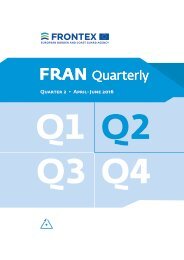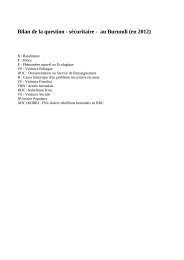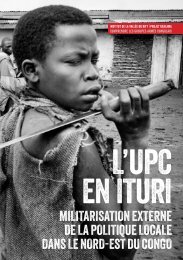You also want an ePaper? Increase the reach of your titles
YUMPU automatically turns print PDFs into web optimized ePapers that Google loves.
GOVERNANCE<br />
at least on paper. The first incarnation of IS’s predecessors who claimed to<br />
be a state—the Islamic State of Iraq (ISI), declared in October 2006—had<br />
two cabinets of government ministries, the first announced in 2007 and the<br />
second in 2009. These cabinets included some ministries overlapping with<br />
the present-day diwans, such as ministries for oil, health, and public security.<br />
In practice, however, these ISI ministries amounted to little in terms of<br />
governance, even though documentary evidence emerging from the period<br />
shows a developed internal bureaucracy and criminal organization adept at<br />
generating revenue within areas of operation, as well as limited dependence<br />
on foreign donors. Indeed, the limitations in governance were acknowledged<br />
by ISI itself, in a treatise the group published by Sharia Committees head<br />
Abu Othman al-Tamimi, titled “Informing the People about the Birth of the<br />
Islamic State of Iraq,” which invoked the precedent of the Prophet, whose<br />
enemies far exceeded him in knowledge and capabilities when he set up his<br />
first state entity following the hijra to Medina.<br />
As part of its claim to be the Caliphate, demanding the allegiance of the<br />
world’s Muslims and desiring the conquest of the entire world, IS has sought<br />
to expand beyond Iraq and Syria, giving an impression of territorial control.<br />
This impression is most apparent in the declaration of official affiliates in the<br />
form of new wilayat, deriving from declarations of allegiance to IS from the<br />
areas in question. The Middle East and North Africa region was the target<br />
of the first major wave of IS expansion announced in November 2014, with<br />
wilayat declared in Sinai, Libya, Algeria, Bilad al-Haramayn (Saudi Arabia),<br />
and Yemen. As the sites of official provinces of IS, one might expect these<br />
areas to display signs of IS governance, mimicking the system in Iraq and<br />
Syria. In fact, the picture suggests realization of IS governance in these provinces<br />
is limited; the most successful initiative so far has been in Libya, but,<br />
even there, IS’s fortunes have varied over time.<br />
Generally speaking, a significant obstacle to the realization of IS governance<br />
in the provinces beyond Iraq and Syria has been the lack of real and<br />
contiguous territorial control. For comparison, note that IS governance in<br />
Iraq and Syria gradually became more complex. With the development in<br />
Syria of a network of strongholds and contiguous territory over the first half<br />
of 2014, centered on the city of Raqqa, and then with the seizure of Mosul<br />
and other cities in Iraq in June 2014, the territory came to span the borders<br />
and served as an important basis for the caliphate declaration. In at least<br />
two of the IS provinces, however—the Algeria province (Wilayat al-Jazair)<br />
and Bilad al-Haramayn (Wilayat Nejd, Wilayat al-Hejaz, and Wilayat al-<br />
31






